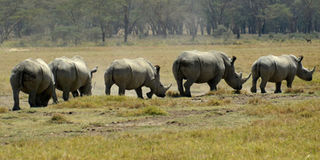China at last gives in to global pressure on rhino horn trade ban

A family of white rhinos feeding at Lake Nakuru National Park. Conservationists can rest easy following China’s decision to postpone restoring the trade on and use of rhino horns and tiger bones, after a decades-long ban, following a global uproar. PHOTO | FILE | NATION MEDIA GROUP
What you need to know:
- China earlier this week announced that implementation of the ban lift had been postponed after further study.
- Kenya has attributed the growth of rhino population over the years to continuous conservation efforts.
- The move to postpone the ban lift has drawn relief from conservation groups and the Kenyan government.
Conservationists can rest easy following China’s decision to postpone restoring the trade on and use of rhino horns and tiger bones, after a decades-long ban, following a global uproar.
The Asian nation earlier this week announced that implementation of the ban lift had been postponed after further study.
“The issuance of the detailed regulations for implementation has been postponed after study. The "three strict bans" will continue to be enforced: strictly ban the import and export of rhinos, tigers and their by-products; strictly ban the sale, purchase, transport, carrying and mailing of rhinos, tigers and their by-products; and strictly ban the use of rhino horns and tiger bones in medicine,” China State Council said in a statement.
LIFT BAN
China announced last month that it was lifting a 25-year ban on use of rhino horns and tiger bones, a move experts said was a step backwards in the fight to save the endangered species. The ban was imposed in 1993.
The move to postpone the ban lift has drawn relief from conservation groups and the Kenyan government.
“Upholding the ban on trade in tiger and rhino parts is a step in the right direction as this ban has been critical in conserving these iconic species. Over the 25 years of the ban, the range States of the two species have recorded growth of populations of their respective species,” the Ministry of Tourism said in a statement.
RHINO POPULATION
Kenya has attributed the growth of rhino population over the years to continuous conservation efforts key among them the 1993 ban on rhino horn trade by China.
Ol Pejeta Conservancy, home to the last two Northern white rhinos, also lauded the move but remains sceptical about the sustainability of the ban. "Resolute campaigning from environmentalists and conservationists, urging Chinese officials to reassess, have clearly made a difference, at least for now. It is up to the rest of us to maintain this pressure, and do whatever we can to keep our endangered species from going back on the market,” it said.
World Wildlife Fund (WWF) also called for a cautious review of the suggestions made by china to lift the ban. Decades of poaching have rendered tigers and rhinos endangered, with less than 4,000 wild tigers currently remaining in the wild.




